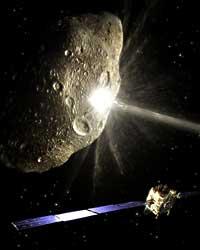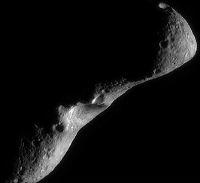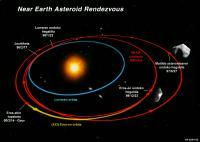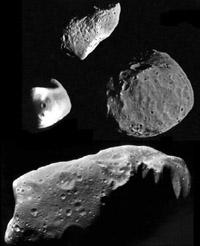Apophis: a spatial caress or a cosmic skillet?
2007/03/30 Galarraga Aiestaran, Ana - Elhuyar Zientzia

Although the argument is discussed whether it is original or not, it is even more debatable the effectiveness of the method that the asteroid chooses to avoid the impact on Earth. In fact, if the asteroid was reduced, it would be possible to replace a large object with several small objects. And those little objects would still touch the Earth as the first big ones. Thus, instead of reaching Earth a bullet, a shot would arrive. It is therefore not a suitable solution.
In any case, all this is science fiction... or not? No, the risk of an asteroid hitting the Earth is not science fiction, but something that can really happen. Astronomers call NEO (Near Earth Object) asteroids that cross the Earth's orbit and care for them if any of them are in danger of hitting the Earth as soon as possible.
One such NEO is the asteroid Apophis, which has lately become very famous in concluding that astronomers were at risk of hitting the Earth. That's when they first saw him and called him 2004 MN4. At first they did not pay much attention, but when they calculated the orbit, they saw that in 2029 it was going to pass very close to the Earth, which could collide with it on April 13, 2029.
Hitting the Earth would cause a huge disaster. According to studies, this is a piece of stone 300 meters long, five times greater than the object that 50,000 years ago touched the Earth in Arizona. And that object opened a 1,200 metre wide crater!
The last object found on Earth was approximately six times smaller than Apophis. It did not reach the land surface, exploded over Tunguska in Siberia in 1908. The windows of the houses located in a radius of 60 km broke and the force of the explosion launched into the air at 30 km. In addition, 2,100 km 2 forests were burned.
Given these examples, there is no doubt that the Apophis collision would have terrible consequences. However, for the moment there is no cause for concern. After this first study, astronomers collected more data and determined the orbit of Apophis. This way corrections were made and they realized that it is not as dangerous as was believed. However, at the closest moment to Earth, the Moon will be closer to her.
The orbit of Apophis around the Sun is similar to that of Earth, so they are sometimes closer and others farther away. Before 2029 it will be quite close in 2013 and also in 2021. And then it will approach again in 2036.
Precisely, astronomers are watching this year. And, although they are convinced that in 2029 will not touch the Earth, they now believe that in 2036 there can be danger. The issue is that the approach of 2029 will affect the orbit of the asteroid. It has been calculated that if you go through a specific area of a kilometer and a half, in 2036 you will be willing to fight the Earth. It is difficult to pass through this area, it is like passing through the eye of the needle, but there is possibility.
However, before panic spreads, astronomers should fine-tune calculations. Space agencies have several projects to determine the path of the asteroid, such as sending a probe to the asteroid and installing a radio emissary in the asteroid for extensive monitoring. But it is not the only proposal and the Planetary Society has organized a contest to reward the best idea.
Others have looked later and although Apophis confirmed that there is danger of hitting the Earth, they are studying alternatives to avoid this shock. For example, ESA, the European Space Agency, supports the project of the Spanish company Deimos Space. It is called Don Quixote and it is proposed to send two probes: Sancho first collected information and, if confirmed that the asteroid should deviate, Hidalgo. Hidalgo would have a mass of 500 kg and believe that, colliding with the Apophis at 10 km/second, he would manage to change his orbit.
For its part, an American group proposes a project called gravity tractor. It is about placing a probe near the apophis, 400 meters high, where it stops. Thus, asteroid and container would attract each other by the force of gravity, and gradually the probe would reduce the asteroid. This would supposedly be enough to change the orbit.
These intentions, of course, serve not only for the case of Apophis, but for any other asteroid or comet. In fact, this time Apophis has created the concern, but in space there are many asteroids and objects that astronomers only know a few. But take care of the sky just in case.
Published in Gara.

Gai honi buruzko eduki gehiago
Elhuyarrek garatutako teknologia





